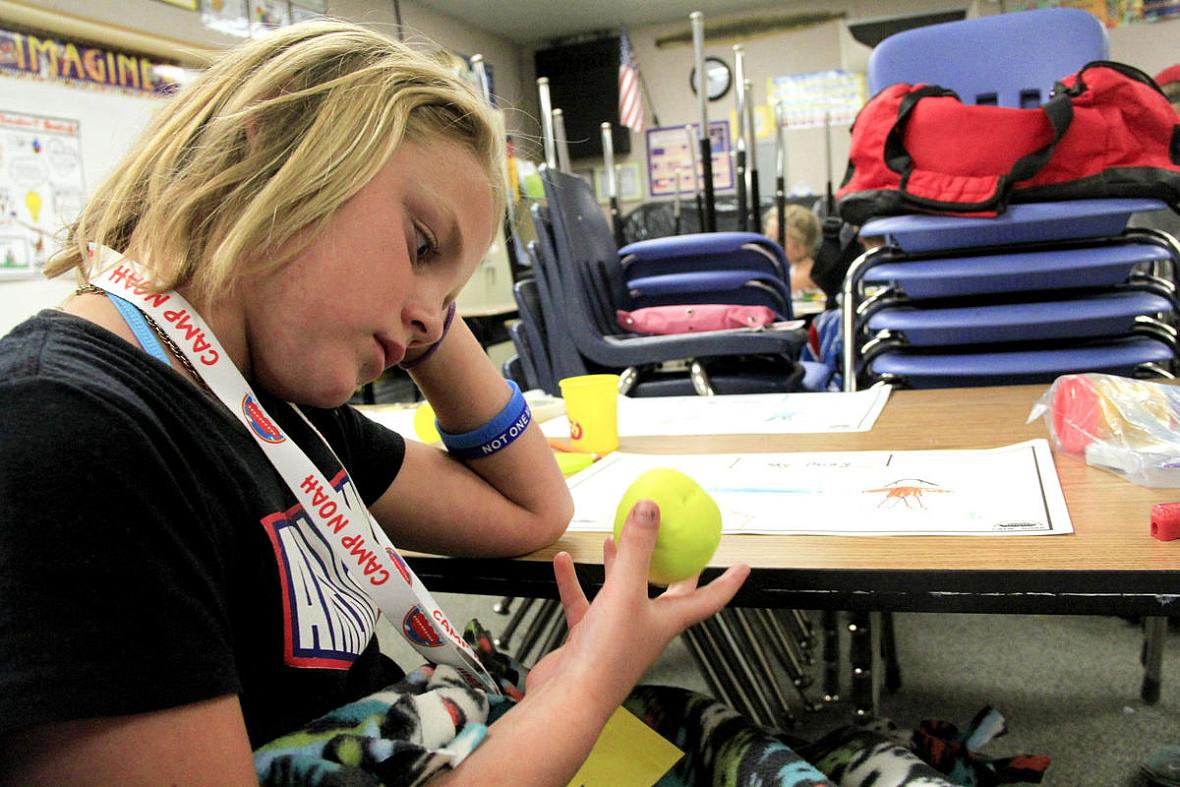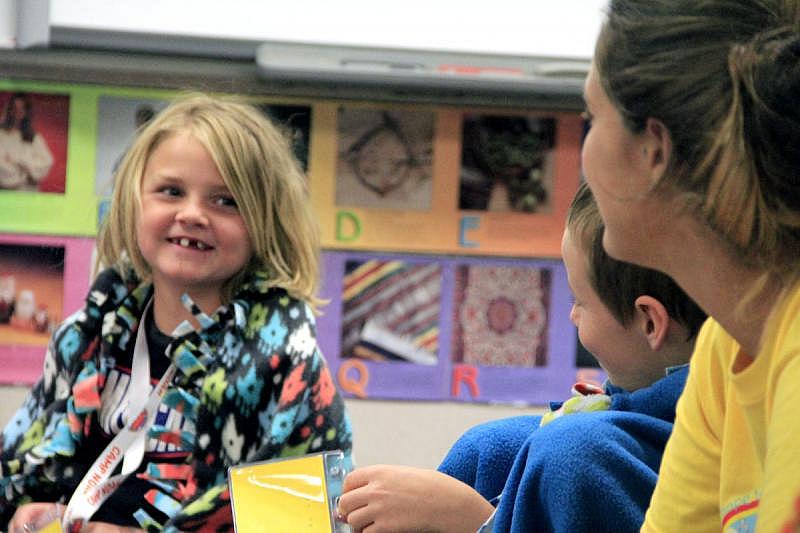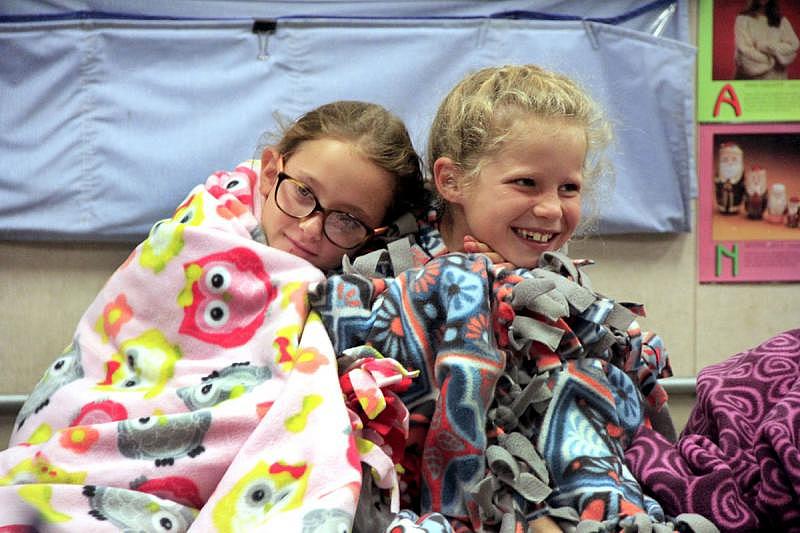A year after the Erskine Fire, kids are still grappling with trauma
Harold Pierce wrote this story while participating in the USC Center for Health Journalism's California Fellowship.
Related: 'An invisible crisis': Toxic stress is helping to shorten life spans in many Kern County communities

Reba Alexander, 8, has a tough time sharing her story of the day the Erskine Fire ripped through the Kern River Valley in June 2016. Harold Pierce/The Californian
WELDON, CA — Reba Dimeglio picked up a crayon and colored in the traumatic parts of her life.
The chaos of that day — the one where her family nearly lost everything — left the details hazy, but she recalled the broad contours. She remembered her mother defying evacuation orders to protect her house, armed with nothing more than a green garden hose letting loose a steady blue stream of water on their home, outlined in an orange glow.
Reba Dimeglio, 8, shares a lighter moment with her friends during camp Noah, a weeklong program designed to help children survivors of the Erskine Fire recover.
Reba’s mother insisted her family flee to safety. She wouldn’t see her for hours, which for a 7-year-old could seem like a lifetime.
“Me and my brother were really worried and we started crying,” Reba said, recalling the day she fled Lake Isabella to Wofford Heights to escape the Erskine Fire, the most destructive wildfire in Kern County history, and among the worst in state history. It killed two, charred hundreds of homes, scorched 48,000 acres and left thousands displaced in June 2016.
Reba’s father tried to play with his kids after evacuating to keep their minds off it, “but I couldn’t forget about it,” Reba said.
Her brother ran to hide in his dad’s truck, left frustrated and confused about whether he might ever see his mom and home again. Reba ran in after him.
“I said, ‘It’s OK, brother,’” Reba recalled telling him. “‘We’ll be back home soon.’”
‘An ongoing disaster’
The Erskine Fire’s flames might have long been extinguished but one year later, the devastation from those three weeks of destruction hasn’t yet subsided – especially among the children who were left grappling with how to deal with such a traumatic experience.
That’s why Reba joined 62 other children who survived the blaze at Camp Noah this month, a week-long program hosted at South Fork Elementary School that teaches kids resiliency and coping skills in the face of trauma and natural disasters.
“We have an intentional focus on building those skills so they can use those to process the disaster of the Erskine Fire last year, and even into adolescence and adulthood,” said Amanda Allen, a senior program manager with Camp Noah, a Minnesota-based Lutheran camp that has deployed to help children after high-profile national incidents including the Sandy Hook Elementary School massacre, the civil unrest in Ferguson, Mo., following the police shooting of an unarmed black man and the water crisis in Flint, Mich.
These are the kids who survived, but don’t know how to deal with their emotions. The ones who act out of frustration or bury it within themselves, withdraw and have “feelings of hopelessness,” Allen said.
That’s not uncommon after a disaster like Erskine. Robin Shive, superintendent of Kernville Union School District, said her staff has noticed increased anxiety among students and have been bringing extra counselors onto campus to help them cope and understand their feelings. Many still have nightmares.
"Anytime there's another fire, they think, 'Is that coming to get us?'" Mark Gordon, chief nursing officer at Kern Valley Hospital, said.
Any reminder of the fire could re-traumatize the kids, Allen said.
That’s difficult to avoid in the Kern River Valley, where wildfires are a part of the landscape. Just weeks after Erskine, the Cedar Fire sparked on the opposite side of Isabella Lake west of Kernville. For many students, it was the first day of school – a day that should have signified a return to normalcy.
Those kinds of reminders can be extremely retraumatizing, Allen said.
“It seems to be an ongoing disaster,” Allen said.
Dr. Anthony Iton, senior vice president of The California Endowment — a private statewide health foundation — likened the trauma of the Erskine Fire to the devastating Lake County Fire that scorched 76,000 acres in 2015 northwest of Sacramento.
Both are rural, working-class communities that struggle with meth and opiate addiction, Iton said. They’re hallmark examples of chronic, or toxic, stress: a constant overloading of the body’s stress response systems that leads to a lifetime of health problems.
It’s brought on by childhoods marked with unabating stressors like broken homes, domestic violence, drug addiction, alcohol abuse and depression — all issues in the Kern River Valley.
“An enormous fire adds acute stress to the chronic stress, and there’s now some evidence of adverse health outcomes, particularly if your family suffers the loss of a home or possessions, or God forbid, loss of life,” Iton said. “Being evacuated and being uncertain about whether your home is intact, whether your pets are alive, your school or friends are safe — that’s classic trauma.”
Shive said her hope is that children attending the camp “will be more resourceful and have hope in the face of trauma — no matter what the trauma is.”
‘It survived because he was fighting’
Samantha Wyly and Charlotte Hafenfeld snuggle up in handmade quilts donated to those who attended Camp Noah, which helps kids who have suffered trauma from natural disasters, like the Erskine fire, cope and recover.
The camp gave kids the opportunity to do something many likely haven’t: open up with other kids about their shared experiences.
About 15 children gathered round in a circle on this day, snuggled up in handmade quilts volunteers made and donated from around the country. They were, for all intents and purposes, security blankets.
They listened to a reading of Two Bobbies, a story about a blind cat and dog who found each other in the fallout of Hurricane Katrina, and through friendship defied odds to survive.
“We survive with the help of other people and through friendship and love,” Michelle Neri-Lorette, a Camp Noah counselor, told the kids. “Everyone is special. We get through things together.”
In a community as small as the Kern River Valley, and a fire as destructive as Erskine, there are few who weren’t personally affected, and fewer who don’t know somebody who suffered a loss.
That became clear as kids shared their stories, a process camp counselors softened by giving the kids crayons and coloring sheets with the heading “My story” to illustrate their experiences.
But most kids were vocal about their losses.
“My house almost got burned,” said a little boy wearing an Erskine Fire shirt honoring first responders.
“My house, my attic, my whole room burned and we had to move to Onyx for a whole year,” said a little girl.
“It was a huge fire. I got really scared my dad’s house would get burned, and my grandma’s house got burned,” said a chatty 8-year-old boy who sauntered from counselor to counselor repeating himself in a smooth monotone: “My dad’s house almost got burned.”
There are reminders of the blaze everywhere.
There’s the bare mountainsides and burnt trees; the walkways leading nowhere but places where homes used to sit; the tattered American flag waving in South Lake that survived, even though the home it belonged to didn’t.
That’s where Evelett Alexander was the day the fire started. She pointed to her coloring sheet.
“That’s my house on fire,” she said, embellishing a red hot home she drew, plumes of black smoke rising over a tiny stick figure sketch of herself.
As the fire approached, Evelett’s dad told her to pack her tablet, two pairs of clothes and four Lunchables. She had about 15 minutes, and then the fire was in her backyard.
It swallowed up her home as she fled with her father and three dogs to safety at a cousin’s house. A few weeks ago, her family moved into a new home in Lake Isabella provided by the Federal Emergency Management Agency.
It’s a far cry from 12 months ago when across town, her uncle fought the fire behind his Mt. Mesa home, Evelett said. Unlike Evelett’s home, his survived.
“It survived because he was fighting,” Evelett said. “He’s not a firefighter, but he did it to save his daughters.”
She took her crayon drawing and held it up, sharing her story with the other kids in the circle who were all clutching drawings, stories and emotions just like hers.
[This story was originally published by The Bakersfield Californian.]
[Photos by Harold Pierce/The Californian.]

